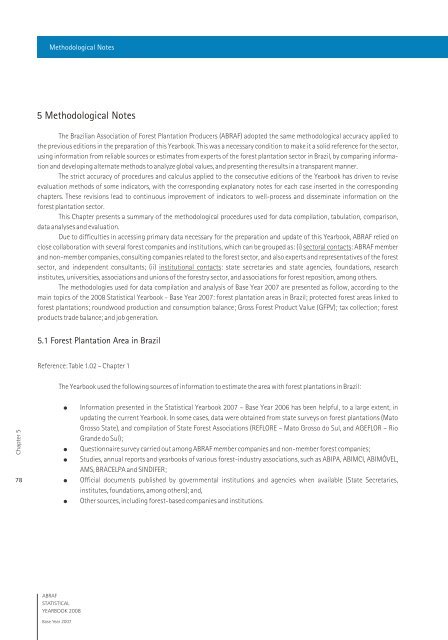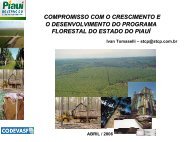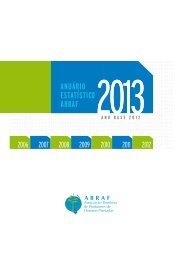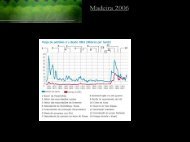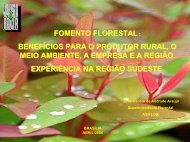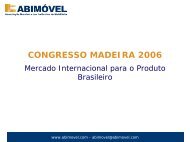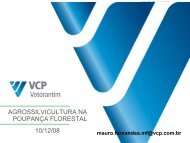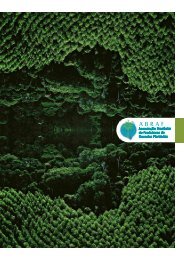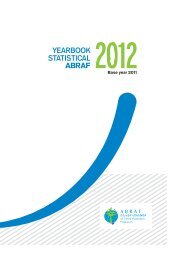ABRAF STATISTICAL YEARBOOK - Associação Brasileira de ...
ABRAF STATISTICAL YEARBOOK - Associação Brasileira de ...
ABRAF STATISTICAL YEARBOOK - Associação Brasileira de ...
Create successful ePaper yourself
Turn your PDF publications into a flip-book with our unique Google optimized e-Paper software.
Methodological Notes5 Methodological NotesThe Brazilian Association of Forest Plantation Producers (<strong>ABRAF</strong>) adopted the same methodological accuracy applied tothe previous editions in the preparation of this Yearbook. This was a necessary condition to make it a solid reference for the sector,using information from reliable sources or estimates from experts of the forest plantation sector in Brazil, by comparing informationand <strong>de</strong>veloping alternate methods to analyze global values, and presenting the results in a transparent manner.The strict accuracy of procedures and calculus applied to the consecutive editions of the Yearbook has driven to reviseevaluation methods of some indicators, with the corresponding explanatory notes for each case inserted in the correspondingchapters. These revisions lead to continuous improvement of indicators to well-process and disseminate information on theforest plantation sector.This Chapter presents a summary of the methodological procedures used for data compilation, tabulation, comparison,data analyses and evaluation.Due to difficulties in accessing primary data necessary for the preparation and update of this Yearbook, <strong>ABRAF</strong> relied onclose collaboration with several forest companies and institutions, which can be grouped as: (i) sectoral contacts: <strong>ABRAF</strong> memberand non-member companies, consulting companies related to the forest sector, and also experts and representatives of the forestsector, and in<strong>de</strong>pen<strong>de</strong>nt consultants; (ii) institutional contacts: state secretaries and state agencies, foundations, researchinstitutes, universities, associations and unions of the forestry sector, and associations for forest reposition, among others.The methodologies used for data compilation and analysis of Base Year 2007 are presented as follow, according to themain topics of the 2008 Statistical Yearbook - Base Year 2007: forest plantation areas in Brazil; protected forest areas linked toforest plantations; roundwood production and consumption balance; Gross Forest Product Value (GFPV); tax collection; forestproducts tra<strong>de</strong> balance; and job generation.5.1 Forest Plantation Area in BrazilReference: Table 1.02 – Chapter 1The Yearbook used the following sources of information to estimate the area with forest plantations in Brazil:Chapter 578Information presented in the Statistical Yearbook 2007 – Base Year 2006 has been helpful, to a large extent, inupdating the current Yearbook. In some cases, data were obtained from state surveys on forest plantations (MatoGrosso State), and compilation of State Forest Associations (REFLORE – Mato Grosso do Sul, and AGEFLOR – RioGran<strong>de</strong> do Sul);Questionnaire survey carried out among <strong>ABRAF</strong> member companies and non-member forest companies;Studies, annual reports and yearbooks of various forest-industry associations, such as ABIPA, ABIMCI, ABIMÓVEL,AMS, BRACELPA and SINDIFER;Official documents published by governmental institutions and agencies when available (State Secretaries,institutes, foundations, among others); and,Other sources, including forest-based companies and institutions.<strong>ABRAF</strong><strong>STATISTICAL</strong><strong>YEARBOOK</strong> 2008Base Year 2007


